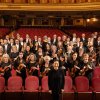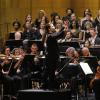When the San Francisco Opera announced its Beethoven & Falla concert earlier this year, the draw was obvious: Beethoven’s Fifth Symphony, perhaps the most recognizable work in all of classical music. The company had sold out last year with Beethoven’s Ninth, so tapping his star power again was a logical move.
What wasn’t expected — or easy to parse — on Saturday, Nov. 1 was the program’s first half, devoted to two light works by the 20th-century Spanish composer Manuel de Falla. On paper, the pairing seemed like a stretch, though in The Three-Cornered Hat, a ballet whose three-excerpt suite featured in this concert, de Falla quotes the famous four-note motif that opens the Beethoven work.
More than anything else, the two composers share celebrity. Within the admittedly modest category of Spanish classical composers, de Falla is essentially considered Beethoven-level famous.
The title of de Falla’s Seven Popular Spanish Songs, which opened the program, refers to the folk origins of melodies de Falla collected in Spain and freely adapts here. It’s also a ubiquitous work. Originally composed for voice and piano, this collection exists in arrangements for practically every combination of instruments.
But de Falla didn’t orchestrate the version performed on Saturday, and the accompanying lines often blurred with the melodies. You could hear enough of mezzo-soprano Daniela Mack to appreciate her gorgeously dark tone. The balance, however, was off.
Onstage, the orchestra was some 20 feet further back than they are when they play opera in the pit (this week, for Wagner’s monstrously long “Parsifal”). Far be it from me to suggest that the orchestra should have stayed in the pit, but this configuration didn’t work. Led by Opera Music Director Eun Sun Kim, the orchestra sounded distant and occasionally tentative in Suite No. 2 from The Three-Cornered Hat. Yet in some passages, their restraint paid off, revealing a nuanced, understated beauty.
The “Dance of the Neighbors” was all soft edges, each splash of orchestral color sounding distinct without any individual part pulling too much attention. Even the raspy flamenco-influenced passages later in the piece were tempered with sweet swaying.
The final tableau had its fair share of bravado — it’s the ballet’s grand finale, after all. The middle movement, a peacocking farruca, couldn’t help but swagger. But machismo isn’t this music’s defining quality. Since de Falla despised stereotypes, it’s not necessarily a bad thing if this performance was less fiery than smoldering.
Still, Beethoven’s Fifth was by far the most assured performance of the evening. The orchestra’s sections were tight. Every solo was executed well. The delicate moments, memorably the fugal layering, were lacy fine. Sometimes, the music was even surprising — an especially exuberant viola flourish in the scherzo, for example.
Throughout the finale, Beethoven’s major-key assertion of all that is good, gravity and sweep were in perfect harmony. The sound was newly loud and rounded, as if from one of the great recordings of old — only right in front of you, live.




